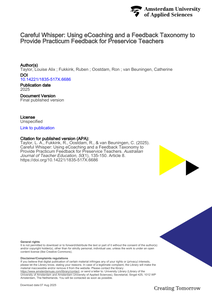In deze workshop hebben deelnemers, in tweetallen, een Bluetooth Low Energy device ontwikkeld met behulp van de MBED online embedded-software omgeving en het Nordic ontwikkelbord. Deelnemers hebben ervaren hoe eenvoudig het is om een embedded-software te ontwikkelen met MBED en hoe eenvoudig het is om het platform draadloos aan een smartphone te koppelen. Wij hebben laten zien dat de ontwikkelomgeving eenvoudig is dat het ook studenten en leerlingen hier snel mee aan de slag kunnen. Voor de workshop is enige kennis van C++ gewenst. De workshop was gericht op iedereen die nog nooit met embedded systemen hebben gewerkt. De workshop is beschikbaar via https://os.mbed.com/users/wkleunen/code/saxion_nioc/
LINK
Urban environments are full of noise and obstacles, and therefore potentially dangerous and difficult to navigate for the visually impaired. Using Bluetooth beacons and a smartphone app we guide them through these environments by providing the information needed for that specific location. We present the preliminary results concerning the usability of our approach.
DOCUMENT

As Vehicle-to-Everything (V2X) communication technologies gain prominence, ensuring human safety from radiofrequency (RF) electromagnetic fields (EMF) becomes paramount. This study critically examines human RF exposure in the context of ITS-5.9 GHz V2X connectivity, employing a combination of numerical dosimetry simulations and targeted experimental measurements. The focus extends across Road-Side Units (RSUs), On-Board Units (OBUs), and, notably, the advanced vehicular technologies within a Tesla Model S, which includes Bluetooth, Long Term Evolution (LTE) modules, and millimeter-wave (mmWave) radar systems. Key findings indicate that RF exposure levels for RSUs and OBUs, as well as from Tesla’s integrated technologies, consistently remain below the International Commission on Non-Ionizing Radiation Protection (ICNIRP) exposure guidelines by a significant margin. Specifically, the maximum exposure level around RSUs was observed to be 10 times lower than ICNIRP reference level, and Tesla’s mmWave radar exposure did not exceed 0.29 W/m2, well below the threshold of 10 W/m2 set for the general public. This comprehensive analysis not only corroborates the effectiveness of numerical dosimetry in accurately predicting RF exposure but also underscores the compliance of current V2X communication technologies with exposure guidelines, thereby facilitating the protective advancement of intelligent transportation systems against potential health risks.
MULTIFILE

The aim of this paper is to design and test a smartphone application which supports personalized running experiences for less experienced runners. As a result of a multidisciplinary three-step design approach Inspirun was developed. Inspirun is a personalized running-application for Android smartphones that aims to fill the gap between running on your own (static) schedule, and having a personal trainer that accommodates the schedule to your needs and profile. With the use of GPS and Bluetooth heart rate monitor support, a user's progress gets tracked. The application adjusts the training schedule after each training session, motivating the runner without a real life coach. Results from three user studies are promising; participants were very satisfied with the personalized approach, both in the profiling and de adaptation of their training scheme.
DOCUMENT

Urban environments are full of noise and obstacles, and therefore potentially dangerous and difficult to navigate for the visually impaired. Using Bluetooth beacons and a smartphone app we guide them through these environments by providing the information needed for that specific location. We present the preliminary results concerning the usability of our approach.
DOCUMENT
Naast sport- en beweegaanbod en ruimtelijke ordening biedt ook innovatieve technologie nieuwe mogelijkheden om mensen te stimuleren meer te bewegen. Op basis van onderzoeksresultaten en praktijkrealisaties in Amsterdam en Eindhoven worden mogelijkheden die innovatieve technologie kan bieden voor een actieve en sportieve leefstijl en leefomgeving weergegeven. Ook worden voorbeelden gegeven van persoonlijke evidence based hardloop apps en andere interactieve technologieën (zoals beacons en interactieve hardloop en wandelroutes) om beweeggedrag in de openbare ruimte te vergroten.
DOCUMENT

Many institutes for initial teacher education struggle to organise effective performance feedback within the context of student teaching practicum. As the cooperating teachers who provide this feedback bring their individualised ontologies, feedback practices have been characterised by inconsistencies in the amount and quality of performance feedback. In this small-scale study carried out in the Netherlands, we explored affordances of eCoaching using a standardised feedback taxonomy. With the help of Bluetooth technology and the Synchronous Online Feedback Taxonomy, four teacher educators provided eCoaching to eight preservice teachers over the course of three lessons. We interviewed teacher educators and preservice teachers about their experiences with eCoaching using the feedback taxonomy during secondary school practicum. Overall, both groups of participants were positive about eCoaching using the taxonomy. Teacher educators observed preservice teachers self-regulating when implementing prior feedback in their lessons. Preservice teachers indicated increased confidence following the lessons with eCoaching.
DOCUMENT

DOCUMENT
In deze factsheets wordt weergegeven welke apps of sporthorloges gebruikt worden en waarvoor deze wearables gebruikt worden. Ook is er aandacht voor kenmerken van deze groepen en hun tevredenheid over de wearables.
MULTIFILE
